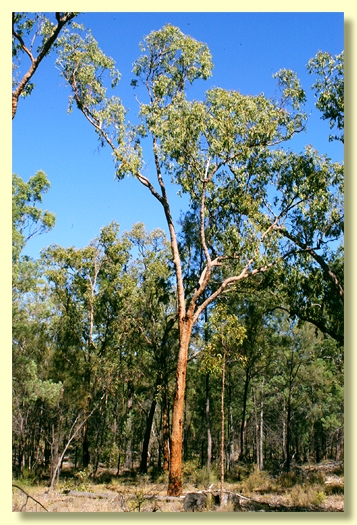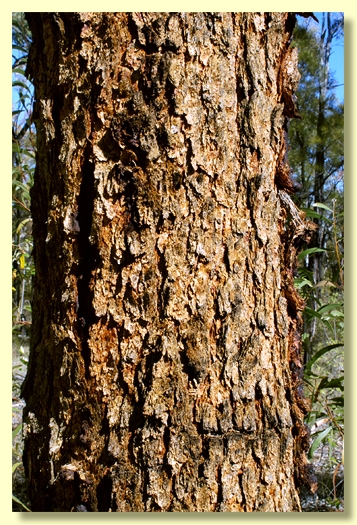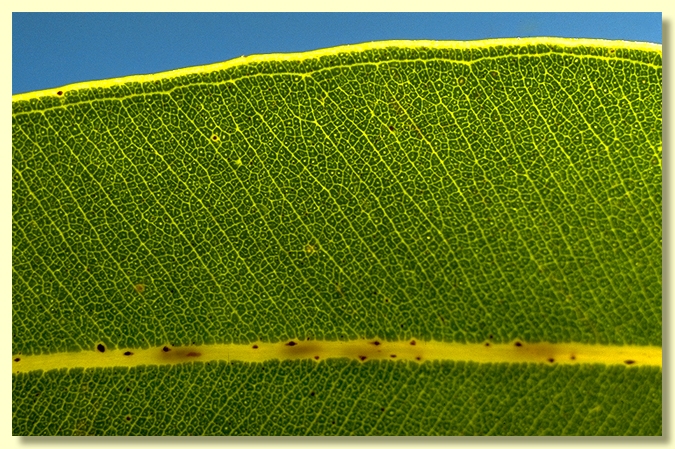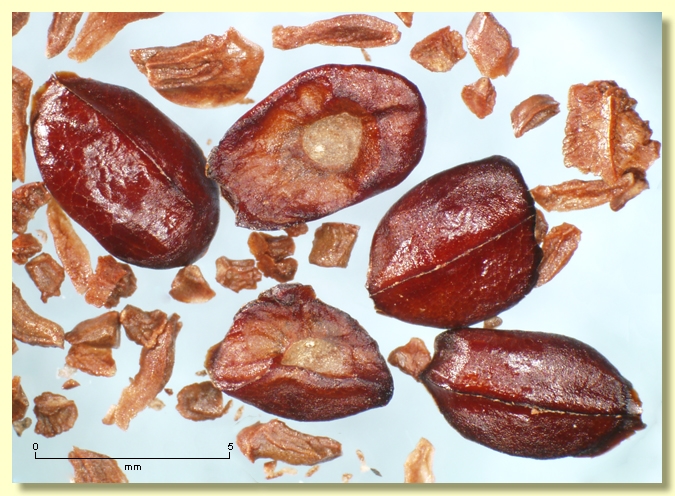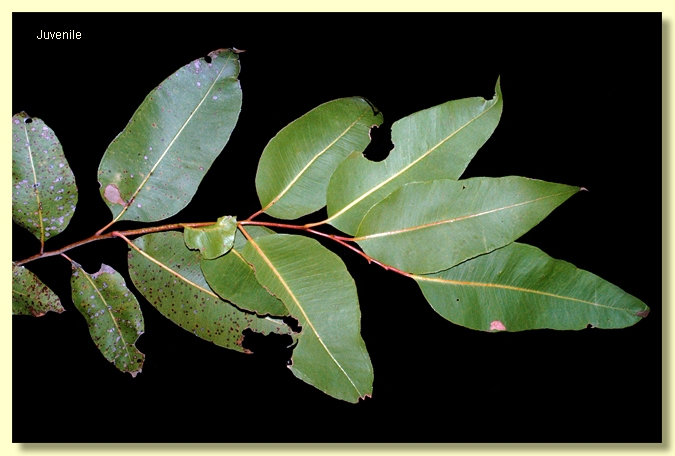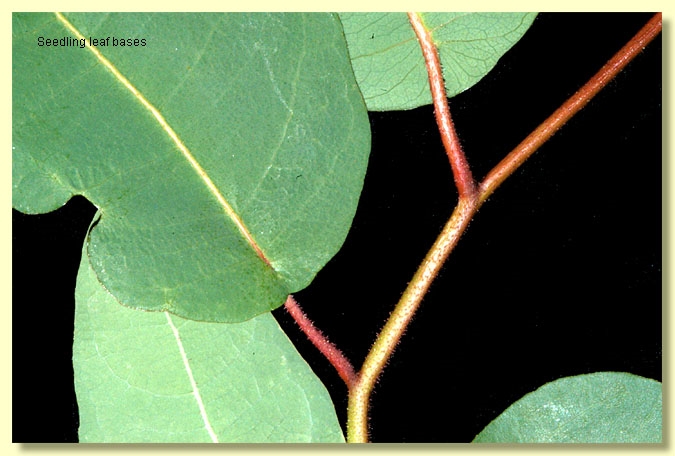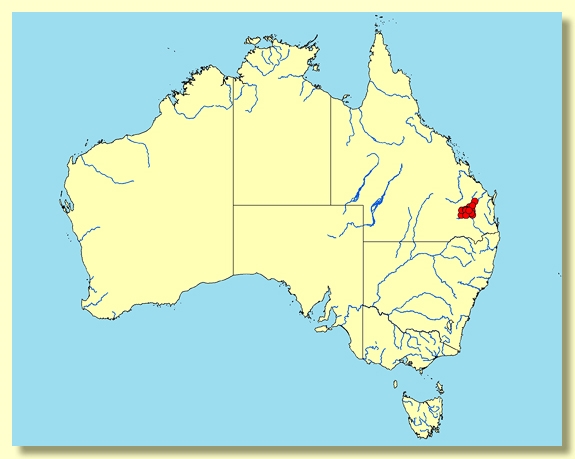Euclid - Online edition
Corymbia bloxsomei
Corymbia | Ochraria
Corymbia bloxsomei (Maiden) K.D.Hill & L.A.S.Johnson, Telopea 6: 372 (1995).
Eucalyptus bloxsomei Maiden, Crit. Revis. Eucalyptus 7: 315 plate 275 (1926). T: Hippong, Queensland, Oct. 1919, H.S.Bloxsome s.n.; lecto: NSW 10104, fide K.D.Hill & L.A.S.Johnson (ibid.).
Tree to 20 m tall. Forming a lignotuber.
Bark rough almost to the smallest branches, thick, soft, loosely scaly to tessellated, yellow-brown to yellow-grey over orange-brown.
Branchlets smooth (glabrous); have ± elongated oil ducts in the pith.
Juvenile growth (coppice or field seedlings to 50 cm): stem rounded to square in cross-section, setose to scabrid until up to ca 1 m tall then smooth; juvenile leaves always petiolate, usually alternate, ovate to elliptical, 7–14 cm long, 3.8–6 cm wide, base rounded at lower nodes then tapering (not peltate), apex rounded to pointed, green, discolorous, becoming glossy, lowest leaves slightly scabrid along main veins but subsequent leaves glabrous except on petioles.
Crown entirely of glabrous Adult leaves; leaves alternate, petiole 1.3–3.5 cm long; blade lanceolate or falcate, (8.8)11–18.8cm long, 1–3.5(5.1) cm wide, flat, base tapering to petiole, apex finely pointed, margin entire, concolorous, glossy, green, penniveined, densely to very densely reticulate, intramarginal vein parallel to and just within margin, oil glands island, small, numerous, 1 per areole.
Inflorescence terminal compound, peduncles 0.4–2.3 cm long, buds 7, 9 or 11 per umbel, pedicels 0.1–0.7 cm long. Mature buds obovoid to cylindrical (0.9 cm long, 0.7 cm wide), scar present (outer operculum shed early), flattened to rounded and apiculate or umbonate, or conical, sometimes wider than hypanthium, stamens inflexed, anthers ± oblong, versatile, dorsifixed, dehiscing by longitudinal slits (non-confluent), style long, stigma blunt or tapered, locules 3, the ovules arranged in 5 ± vertical rows on the placentae. Flowers creamy white to pale yellow.
Fruit pedicellate (pedicels 0.2–0.6 cm long), barrel-shaped to urceolate or truncate-globose, 1.2–1.8 cm long, 0.9–1.3 cm wide, disc descending, valves 3, enclosed.
Seeds brown to reddish brown and shiny, (2.5)3–6 mm long, boat-shaped with a keel on the smooth and usually cracked dorsal surface, not winged but some seed have a short flange at one end, hilum ventral.
Cultivated seedlings (measured at ca node 10): cotyledons reniform to orbicular; stems rounded in cross-section, setose to sparsely so for at least 10 nodes; leaves always petiolate, opposite for only 2 or 3 nodes then alternate, ovate to lanceolate, 4–21 cm long, 2–8 cm wide, (leaves increase in size considerably at about nodes 8–10), base of lowest leaves rounded, by node 4–5 base peltate until ca node 10 then sub-peltate and then rounded, margin entire, apex pointed, discolorous, green, setae present only on main veins and petioles.
Flowering has been recorded in June and December.
A striking tree endemic to inland south-eastern Queensland from south of Mundubbera to Chinchilla, especially in Barakula State Forest where locally abundant. It prefers deep sandy soils on level to gently undulating sites, where it is a component of warm temperate dry sclerophyll forest. Corymbia bloxsomei has yellowish flaky rough bark throughout, a glossy green crown, terminal compound inflorescences and juvenile leaves that are virtually glabrous.
C. bloxsomei overlaps in distribution with another yellow-bloodwood, C. watsoniana subsp. watsoniana, in the southern part of the latter species' range. C. bloxsomei has glossy leaves from late juvenile phase to the mature crown and fruit less than 1.8 cm long, whereas C. watsoniana subsp. watsoniana has dull green to grey-green crown leaves and fruit 2 cm long or more. C. petalophylla occurs just to the north-east of the distribution of C. bloxsomei and differs also in having dull grey-green adult leaves whilst its fruit are about the same size as those of C. bloxsomei or smaller.
MORE ABOUT CORYMBIA
MORE ABOUT YELLOW BLOODWOODS
Corymbia bloxsomei: after Hans Schreiber Bloxsome (1876–1952).
Hans Bloxsome migrated from England to Australia and became a farmer in Hippong, Queensland. He collected many specimens of this species and sent them to eucalypt botanist J.H.Maiden in Sydney.

